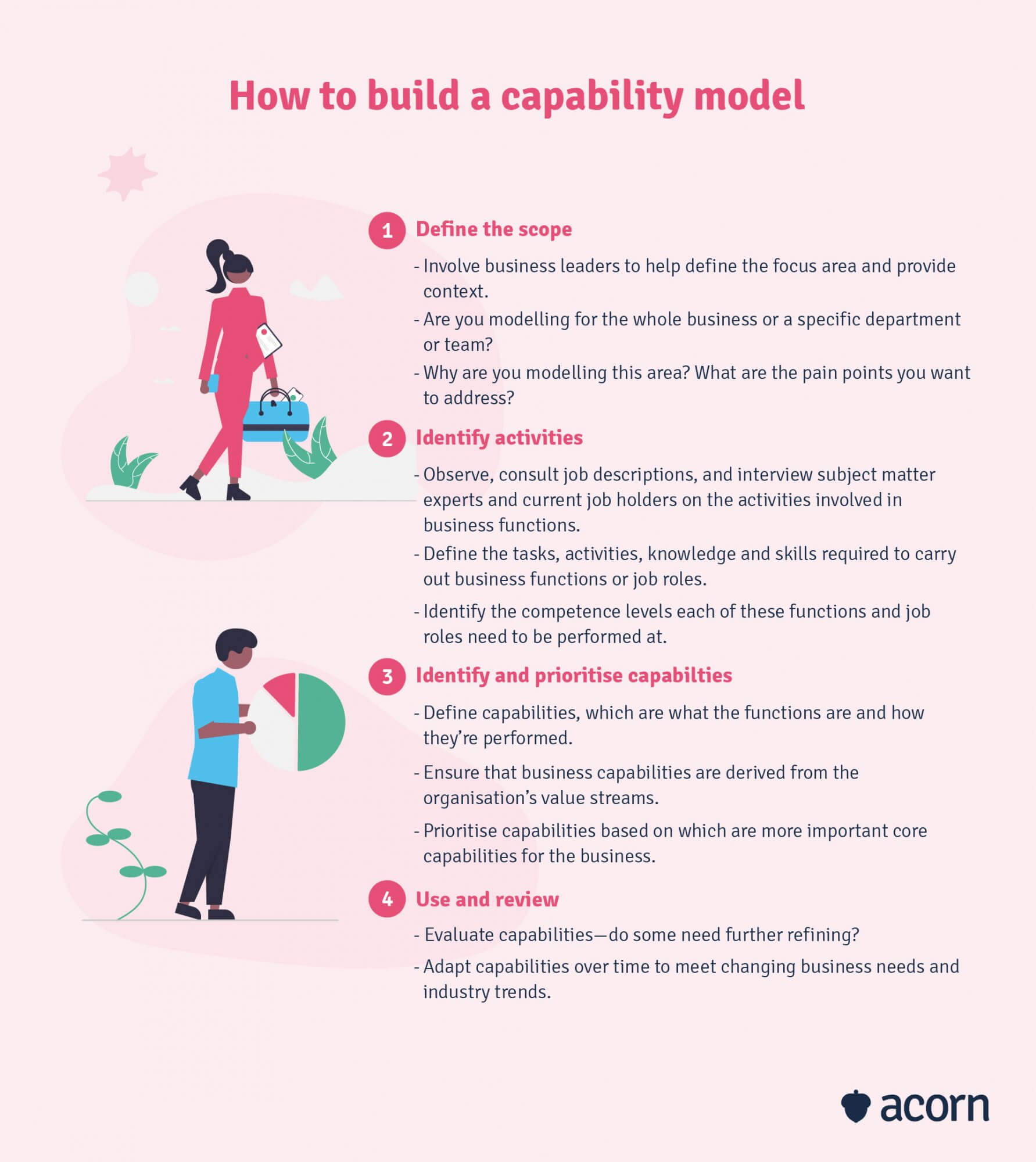What is Capability Modelling and Why is it Important?
Reading Time:

Lead the pack with the latest in strategic L&D every month— straight to your inbox.
SubscribeCapability modelling informs performance management and L&D initiatives. We dive into how capability modelling can be used for business transformation
Businesses are driven by their capabilities, so it goes without saying that you need to understand the skills, knowledge and behaviours necessary for yours to function. This is where capability modelling can help.
By organising and prioritising capabilities, capability models can cut through the technical jargon related to specific job roles and business functions. It allows them to reveal the specific criteria needed to push your jobs or overall organisation closer to its desired target state.
But what exactly are capability models, and why do they matter? In this article we’ll dive into the importance of capability models and how they can be created to forge the best business drivers for organisational success.
What is modelling?
In simple terms, modelling is about displaying or providing visibility. In business, modelling is a way of providing a visual representation of data to internal and external business stakeholders, so they can better understand the organisation, its current capabilities, and its future plans and business strategy.
What is capability modelling?
With that in mind, capability modelling—or capability mapping—is a powerful tool giving a visual representation of the functions, outcomes, expertise, knowledge, behaviours and activities required for employees and the organisation itself to carry out core business operations and job roles.
What does a capability model do?
As we said, it’s a visual representation of the required functions, outcomes and activities that allow a company to work, which really means it’s all about ensuring a company has the right workforce to get the job done.
There are also business capability models, also known as business capability maps, which focus more on business capabilities themselves (the “what” of what businesses do) and how those business capabilities support the organisation’s strategic priorities.
More broadly, business capability maps provide a definitive guide to the capabilities needed in individual teams, business units, and the organisation as a whole, which organisations can use to create a transformational roadmap for the business. It’s an effective way to link capabilities to organisational strategy, driving business value.
Capability modelling assists in:
- Defining clear job descriptions and specific capability requirements to perform job roles efficiently and effectively.
- Reducing training costs and time to proficiency.
- Ensuring employees have the capabilities needed for their role currently and into the future (for career progression and organisational need).
- Developing L&D initiatives to build capabilities for future business needs.
- Measuring and defining competency for a targeted performance management plan.
Ultimately, capability modelling allows businesses to define clear responsibilities and goals for the workforce which can be adapted and built on over time as industry standards change and capability gaps arise.
Here at Acorn, we created the first performance learning management system (PLMS) to assist with capability modelling. It’s a dynamic AI-powered platform that synchronises L&D with business performance. A PLMS is designed to codify and operationalise capabilities to improve organisational efficiency and performance.
And remember: a business capability model is still a capability model. It just fulfils these roles on a business level with business-level capabilities. It can explore the competency of specific teams or departments in the capabilities relevant to their function within the organisation, ensuring that they’re meeting their performance requirements.
How to build a capability model
This is the essential part: Drafting the capability model. This will form the basis of an actionable framework for organisational transformation through capabilities. You can build a capability model in four simple steps.

Step 1: Define the scope
This is your “focus area” that needs to be addressed, like a particular job. If you’re doing business capability modelling, this could be a specific team, department, or business function. Start by asking yourself why this is your focus area. What are the specific pain points in these focal areas that need to be more streamlined or efficient for the business?
Understanding this assists in determining how in-depth your capability model should be. Remember: a business capability is derived from a company’s value chain, so, when creating a business capability model, business leaders and business architects should be involved to provide context.
Step 2: Identify activities
What are the tasks, activities, knowledge, skills and expertise needed to carry out the chosen job or function? Importantly, which of these are needed for carrying out the job or function to the degree (i.e. competency) it needs to be performed at? That’s to say there may be capability gaps between how your workforce performs now and how the same workforce needs to perform in the future.
Use a combination of observation, interviews (with both subject matter experts and the current job holders), job descriptions, and supporting documentation to paint a clear picture of the activities involved in the job or business function.
Step 3: Identify and prioritise capabilities
Capabilities are how you perform those skills, tasks, and activities effectively. Typically, they can be grouped into categories like behavioural (think: Interpersonal skills), operational (think: Innovation), and dynamic (think: Learning and other capabilities that allow dynamic change). In a business capabilities model, capabilities are derived from the organisation’s value streams.
Then you need to prioritise them. Which are the core capabilities for the job or business function? Organise them in a hierarchy to show their relationship to one another, making the capability model easy for users to understand at a glance. (We did say it was a visual representation, didn’t we?)
Step 4: Use and review
Once you implement your capability model, it’s time to evaluate and review. Perhaps some of your listed capabilities will need further refining to support your desired outcomes. Even if you get everything right the first time and your capability model is perfect (this is unlikely, so don’t get too caught up in the details), the fact is that you’ll have to adjust it over time to meet changes in industry standards and processes for both individual job roles and the organisation.
In saying that, capabilities themselves don’t necessarily change (particularly business capabilities), but they do adapt for your business needs. The workforce of today will need new skills, knowledge and expertise to become the workforce of the future, and so their required capabilities will need to evolve to fit with that. Regularly reviewing and updating a capability model allows businesses to maintain a competitive advantage and effectively deliver on business objectives.
What are the risks of not modelling capability?
When you don’t model capabilities, you end up with poor recruitment practices and employees who are unsure of their job responsibilities and requirements due to unclear job requirements. When there isn’t a clear understanding of the capabilities required for each role or team, organisations will struggle to identify the best candidates for the job, leading to poor hiring decisions.
Plus, current employees won’t have a clear understanding of what their job roles entail, driving confusion and a lack of direction. These unclear job requirements lead to high turnover (especially among new hires unsuitable for a position), increased recruitment costs, lost productivity, and a hit to your bottom line.
A lack of capability modelling also means a business has nothing to benchmark their employees against, affecting performance management and L&D strategies. This causes employees to fall behind in the new skills, knowledge and expertise required of individuals in their roles, leading to operational inefficiencies that can snowball out to affect the rest of the business. On an organisational level, a lack of business capability mapping driving capability gaps could be catastrophic, preventing them from meeting strategic priorities, making revenue, or being competitive in the market.
The only way to close those capability gaps is with performance management and L&D, but without capability modelling businesses can’t develop meaningful KPIs for their employees or organisation because they have no capabilities defining the actions, behaviours and skills required to carry out core functions of the business. Employees will have a lack of direction which could—again—see them leaving in search of better professional development opportunities, driving up recruitment and decreasing productivity during the recruitment period.
It also means organisations won’t understand what needs to change to transform the organisation, meaning they’ll be left behind in the market. 94% of employees say they would stay at an organisation longer if their employer invested in their learning and development. So, if a business doesn’t model their capabilities, they can’t see the capability gaps that need to be closed. Ergo, training initiatives will be irrelevant to employees and their roles, causing disengagement, low ROI, decreased performance, and frustration at a lack of career growth and opportunity.
Key takeaways
Capability models are the key to understanding what drives your business success, whether it be through business-level capabilities or individual capabilities for employees. They ensure companies hire the right talent with the right skills, knowledge and behaviour to meet targets and drive business success.
Capability models can be adapted for individual roles or organisation-wide. They can be created in four simple steps:
- Defining the scope of the problem to focus on
- Identify activities required for the job role or function
- Identify and prioritise capabilities in terms of what is most important to your area of focus
- Use and review regularly to keep up with industry change.